Among the infinite number of alternate universes contained in the stories of Marvel  Comics, there lies a world set in the dark and forbidding streets of the gangster-dominated 1920s and ’30s, where the heroes, mostly devoid of superpowers, must rely on their wits to survive every twist thrown at them as they try to solve heinous crimes and make their world a safer place. In February, Upper Deck took us for a ride through this world in their latest expansion to Legendary. Pack a rod and watch your back; this is Noir.
Comics, there lies a world set in the dark and forbidding streets of the gangster-dominated 1920s and ’30s, where the heroes, mostly devoid of superpowers, must rely on their wits to survive every twist thrown at them as they try to solve heinous crimes and make their world a safer place. In February, Upper Deck took us for a ride through this world in their latest expansion to Legendary. Pack a rod and watch your back; this is Noir.
What’s in this set – 5 heroes, 2 Masterminds, 2 Villain Groups, and 4 Schemes.
For previous Legendary sets –
Legendary: A Marvel Deck-Building Game
Captain America 75th Anniversary
New Keywords –
- Hidden Witnesses – In a city this corrupt, getting answers is never easy. Sometimes people won’t talk – maybe the criminals got to them, paid off the right people, are hiding behind a loyal goon or a scapegoat, or maybe the witnesses are just plain scared. Whatever the reason, you’ll have to get past any Hidden Witnesses a villain or Mastermind has before you can confront him. Hidden Witnesses are simply Bystanders; whenever a character captures a Hidden Witness, take the top card of the Bystander stack and place it face down beneath its captor, without looking at it. As long as a villain or Mastermind has at least one Hidden Witness, you cannot attack him. To overcome this problem, you may at any point on your turn and as many times as you can and wish, spend 2 Recruit points to rescue a captured Hidden Witness. If the Bystander has any special text, you play it as normal as you put it in your Victory Pile. A villain may have Hidden Witnesses and normal Bystanders simultaneously, so remember that if the card is face down, you must spend 2 Recruit to rescue it and must rescue it before you can attack, and if the card is face up you will rescue it when you defeat the captor. Both face up Bystanders and Hidden Witnesses function the same way if a villain escapes, however. Also, if a card lets you defeat a villain or Mastermind for free, Hidden Witnesses cannot stop you, and you rescue them like normal Bystanders when you defeat your foe.
- Investigate – If you want to solve a crime, you will have to first investigate the crime. This keyword simulates the heroes searching for clues to uncover the truth. When a card allows you to Investigate, it will name a criterion that you’re searching for, such as “Investigate for a Tech card.” When this happens, looks at the top two cards of your deck. You may draw one and only one of those cards if it meets the criterion. Any that you do not draw you must place on the top or bottom of your deck. You choose where each card goes, so if you don’t draw either card, you may put one of the top and one on the bottom, or both in either location. By default Investigate refers to your deck, but sometimes it will interact with another deck entirely, such as the Villain, Hero, or Bystander decks. The card will explicitly state if it is referring to a deck other than your own; if it doesn’t specify, then it is interacting with your deck.
New Masterminds –
- Charles Xavier, Professor of Crime – In the Noir universe, the X-Men are a
crime organization, led by this world’s version of Charles Xavier. The Professor starts at 8 Attack, but gets +1 for every Bystander (including Hidden Witnesses) in the city and HQ. His Master Strike gives Hidden Witnesses to four heroes in the HQ, ramping his attack up +4 temporarily, and effectively increasing the cost of those heroes by 2 Recruit, since you will have to get rid of the Hidden Witness before you can recruit the hero. (Although, of course, you don’t have to recruit a hero on the same turn as rescuing a Witness.) He leads the X-Men Noir villain group. - The Goblin, Underworld Boss – Starting the
 game with 10 Attack and two Hidden Witnesses, the Goblin is set to be a real pain. His Master Strike takes two random Bystanders from each player’s Victory Pile and gives them to the Goblin as Hidden Witnesses. If you have less than two Bystanders to surrender, you gain a Wound instead. With his above-average Attack value and a wall of meat-shields to hide behind, the Goblin is a formidable adversary. He leads the Goblin’s Freak Show villain group.
game with 10 Attack and two Hidden Witnesses, the Goblin is set to be a real pain. His Master Strike takes two random Bystanders from each player’s Victory Pile and gives them to the Goblin as Hidden Witnesses. If you have less than two Bystanders to surrender, you gain a Wound instead. With his above-average Attack value and a wall of meat-shields to hide behind, the Goblin is a formidable adversary. He leads the Goblin’s Freak Show villain group.
New Villain Groups –
- Goblin’s Freak Show – They appear to be a moderate difficulty group at first, but each one them has an Ambush effect that can and probably will capture Hidden Witnesses, making this a potentially difficult villain group.
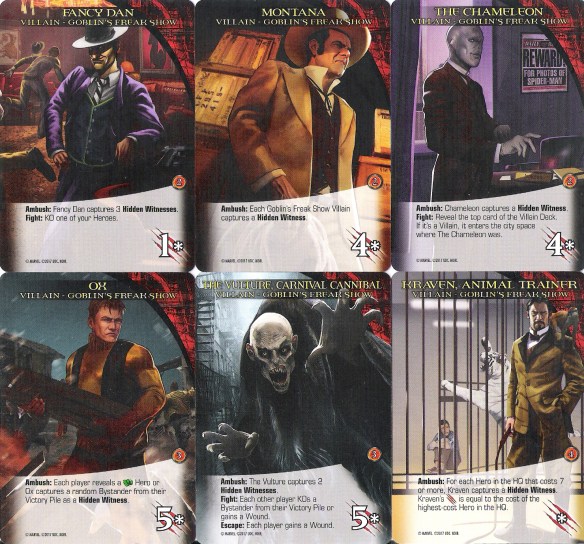
- X-Men Noir – Easy-moderate group with seven unique characters. Every villain in this group makes use of the Investigate keyword, beneficially with the first five characters, and harmfully through Escape effects with the final two.
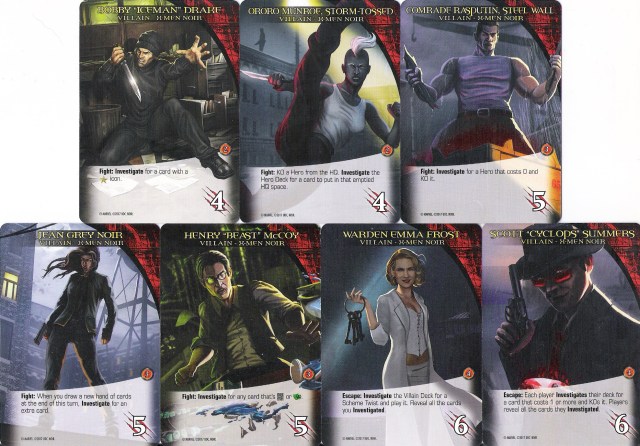
New Schemes – Noir‘s Schemes may not reach the heights of creativity we saw in the Captain America 75th Anniversary set, but they do an admirable job of expanding on the replayability of the game in interesting and thematic ways. “Find the Split Personality Killer” creates a stack with a mix of Bystanders and heroes, which players will have to Investigate in order to figure out who the killer is. Only the players who can correctly identify the killer at the end of the game will win. “Five Families of Crime” is similar to a Scheme from Secret Wars: Volume 1, dividing the Villain Deck into multiple smaller decks with one city space apiece. “Hidden Heart of Darkness” puts the Mastermind Tactics in the Villain Deck, making it possible to win the game early on if you can blitz the Mastermind, but more difficult as the game progresses because the Tactics keep coming back, and you can’t attack the Mastermind while a Tactic is in the city. The final Scheme, “Silence the Witnesses,” either captures Hidden Witnesses with each Twist or sends them to the Escape pile, failing the players if too many Bystanders escape.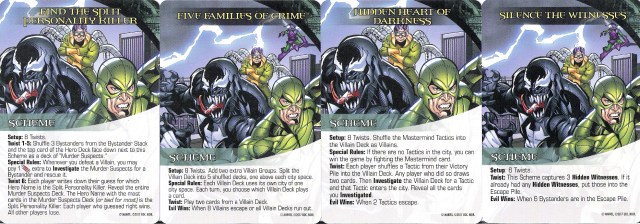
New Heroes – While Noir may not add any new teams, it does expand on four different teams, three of which appear in the base Legendary game, making this an excellent set for anyone who only has the base game and few or none of the other expansions. The Noir heroes, however, don’t really require aid from beyond this set, as they all work together remarkably well, despite their various affiliations. The Investigate mechanic turns out to be a magnificent unifier among heroes who employ it.
Avengers
Iron Man Noir – As one would expect, Iron Man is designed for tech decks, and this version of the hero brings more versatility to the battle than his previous two Legendary incarnations. His first common lets you Investigate your deck for a tech card, which shouldn’t be too difficult if you build to tech. His second common helps in the quest for tech as well, granting you 3 Attack at the expense of putting a card in your hand on top of your deck. So, send a tech card to your deck, and the first common gains a guaranteed draw. Iron Man’s uncommon provides an unique tech superpower, which allows you to copy the Fight effect of a villain with 1 Victory Point from your Victory Pile. Most likely you’d be copying a henchman villain, so this superpower could give you a number of different things depending on which henchmen you have in the Villain Deck, such as gaining +1 Recruit (Hand Ninjas), KOing one of your heroes (Sentinels and others), or drawing an extra card on your next turn (Savage Land Mutates), among other possibilities. His rare is the ultimate best friend of all Investigate cards, allowing you to look at three cards instead of two whenever you Investigate for the rest of the turn! As if that wasn’t good enough, the rare also has an Investigate ability, letting you look for your choice of a card with either Recruit or Attack points. Iron Man Noir pairs well with any tech-oriented hero (of which there are several already in Legendary), or any hero with Investigate. From this expansion, Spider-Man Noir is his best match, as that hero is the only other one in this set with tech and ranged cards.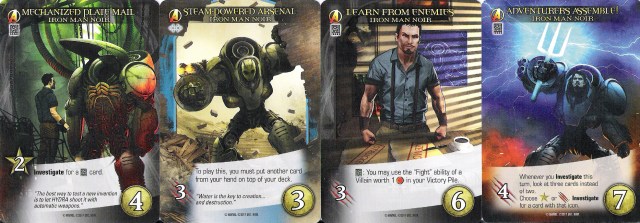
Marvel Knights
Daredevil Noir – The original version of Daredevil from Dark City used a mechanic hinging on a player guessing the current cost of the top card of his deck. That version also included a common that allowed you to put the next hero you recruited on the top of your deck, turning the guessing game into a guaranteed success. Daredevil Noir brings back both mechanics. His first common is similar to one from the original Daredevil, letting you put the next hero you recruit that turn on the top of your deck, while granting 1 Recruit and 1 Attack instead of the original’s 2 Recruit. Daredevil Noir’s second common brings back the guessing game, allowing you to choose a number greater than 0, and then Investigate for a card of that cost. This makes 0-cost heroes a nuisance, but fortunately his uncommon has a solution in the form of a covert superpower, permitting you to Investigate for a card that costs 0 and KO it. The rare is a bit of an odd fit with the rest of his skill set, seeing as how it benefits from 0-cost heroes. The rare makes you discard a card from the top or bottom of your deck, gaining +1 Attack and the ability to repeat the process if the card costs 0. This rare works well with deck manipulators, particularly cards with Investigate, but ironically, if you’re building a deck around Daredevil Noir, his rare may not be the best card for you.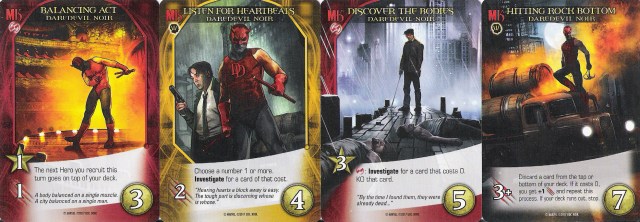
Luke Cage Noir – A strong and resilient man, Luke Cage Noir has the most combat potential of the heroes in this set. All that power comes at a cost, though: 4 or more to be precise. All of Luke’s cards cost at least 4, numbering him among the most expensive heroes in all of Legendary. The high cost is not only worth it, however, it is also necessary to his mechanics. His first common grants Attack points and lets you Investigate your deck for a card with a cost of 4 or more. His second common provides Recruit instead, with additional Recruit for every other card costing 4 or more you played. Luke’s rare cranks the power up – very, very up – by supplying 5 Attack up front and an additional 2 for every card you played with a cost of 4 or more! The uncommon, instead of following the cost mechanic, grants an excellent defense ability with team-play possibilities, allowing you to prevent any player from gaining a Wound, and letting you Investigate for any card as a reward. Overall, Luke Cage Noir may have the best skill set in this expansion, assuming you’re willing to commit to a deck build consisting of only high-cost cards. He partners well with Goliath from Civil War and Kuurth, Beaker of Stone from Villains: Fear Itself, both of whom also have cards with the 4-or-more-cost mechanic.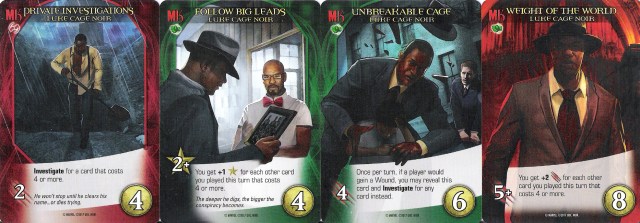
Spider Friends
Spider-Man Noir – Carrying on the Spider Friends tradition, Spider-Man Noir’s cards all cost 2. His first common allows you to Investigate for a card that costs 2 or less, so building a deck of cards that cost no more than 2 is ideal, like with many previous Spider Friends. His second common is a very simple card, granting 1 Attack with an extra 2 locked behind a ranged superpower. Now, the only ranged cards in Noir are this one and Iron Man Noir’s second common, so you’ll either have to cooperate with Iron Man or use heroes from outside this set in order to activate the superpower. Spider-Man’s uncommon grants another superpower, this time activated by instincts, which allows you to Investigate the Bystander stack and rescue one of the cards (also useful for getting those pesky Shapeshifted Copycats from Secret Wars: Volume 2 out of the way). His rare, once again, has a superpower, but this time triggered by the Spider Friends affiliation, all but guaranteed if you’ve been building a Spider Friends deck. The rare’s superpower lets you manipulate the deck of every player through Investigating for a card with a cost of 2 or less in each deck. You get to play a copy of each of those cards before putting them in each player’s discard pile. Employing four different classes, Spider-Man Noir fits with any of the 2-cost Spider Friends, but Silk may be his best companion, as she brings some ranged cards to the table and benefits from multiple classes.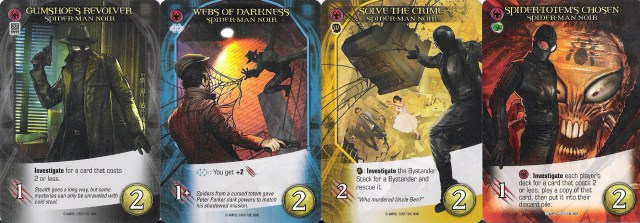
X-Men
Angel Noir – Perhaps fittingly, Thomas Halloway is a bit of a jumble, doing a lot of things, but lacking in coordination. His first common is a simple card, supplying 2 Attack and an additional 1 through an instincts superpower. His second common grants 1 Attack and Recruit, and allows you to Investigate for a hero of a class of your choosing (which does raise the question of whether “No Class” is an acceptable choice). At a cost of 5, Angel’s uncommon is a bit overpriced. It lets you copy the Attack and Recruit of a hero in the HQ, and then requires you to put that hero on the bottom of the Hero Deck. Now, if you’re lucky, you might be able to copy the Attack or Recruit of a rare or uncommon sometimes, but you won’t be able to do it twice in a row, as the copied card gets banished to the bottom of the Hero Deck. Somewhat useful as an HQ manipulator, but if you’re using it for that purpose you’re likely sacrificing good Attack or Recruit numbers to do so. His rare, on the other hand, is beautiful. It only gives you 3 Attack up front, but it lets you Investigate the Hero Deck for any hero, which you then immediately add to your hand! Overall, Angel Noir is the weakest hero in this set, but he does have some very useful card options in his second common and his rare.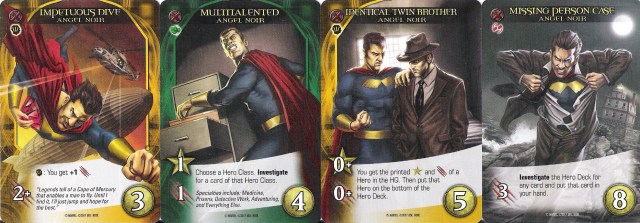
Thematically, this is an excellent expansion, and while the keywords lean to the complex side, they are also quite good, particularly Investigate. I’ll still point to Captain America 75th Anniversary as the best small box set, and Secret Wars: Volume 1 as the best expansion overall, but Noir is more than a worthy inclusion to the world of Legendary. And if you have no other Legendary expansion, Noir would be a great place to start, due to its versatility and additions to multiple teams.
Please can you do more reviews of the expansions that came out after noir. I love your reviews and no other site can do it as well as you.
LikeLike
I agree with Claudia. We need more reviews because they’re excellent!
LikeLike